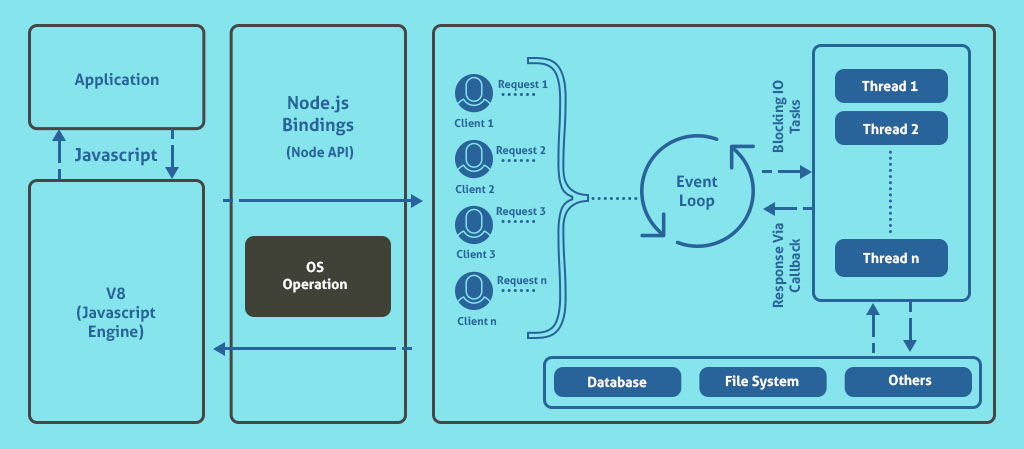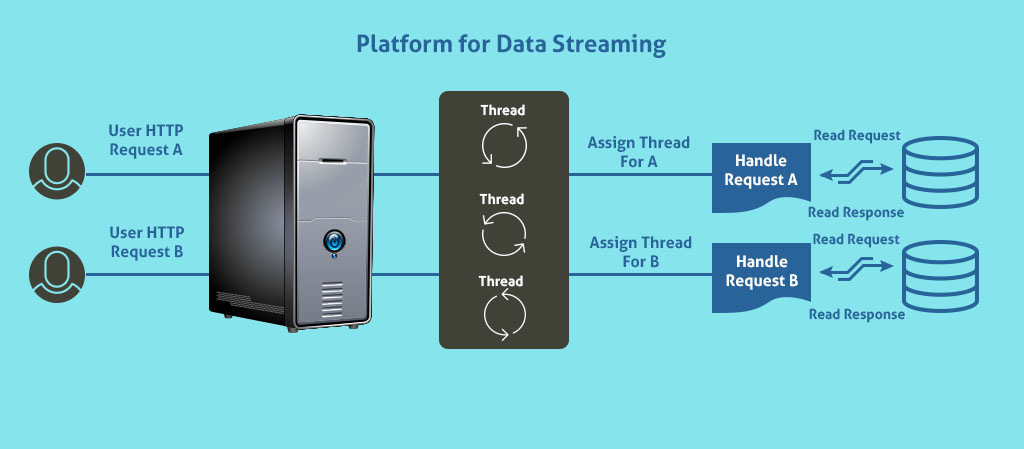
Table of Contents
- Ubiquitous Runtime
- Fast and Scalable
- Easy to Learn and Code
- Highly Extensible
- Dynamic NPM
- Platform for Data Streaming
- Increased Productivity
- Single Codebase for Real-time apps
- Solves Database Queries
- Large and Active Community
- Proxy Server
JavaScript is a master of reincarnations. It has been through its highs and lows, just to pick up that high momentum again. JavaScript has been through the ages of ultimate web development. Every now and then, a new language pops up, storms the web market, and fades away eventually. JavaScript has been a spectator throughout this journey.
Every time the developer community thought that the language is now dead, JavaScript has sprung back. This time, it is through the subsets of its basics. Now, Node.js is not completely an altercation of JavaScript but is highly based on it.
Node.js powers our web applications and has allowed our teams to move much faster in bringing their designs to life.-Jeff Harrell, Director of Engineering at PayPal
Node.js is not even a framework. It is an application runtime environment. It empowers the developer to write JavaScript on the server-side! Imagine using a front-end language outside its environment! Sounds fancy, right? That’s exactly how Node.js empowers you.
Wondering why Node.js, specifically? We’ll talk about the same in detail ahead in the blog. Stay tuned!
Node.js is lightweight and efficient. It uses push technology over web sockets. Both, the client and server can initiate a 2-way communication. Chatbots are a perfect example of this feature. Node.js runs on the standard port 80. Hence, you can use the web app internally or over the internet without any special permissions. It is also efficient in terms of memory usage.
The biggest boost for the language? Back in 2010, JavaScript gained a massive limelight after Google launched their own web browser, Chrome. The V8 engine embedded in the browser allowed for faster processing speeds of the language. The V8 engine gave languages such as Node.js, Backbone.js, Angular.js a huge boost in terms of performance.
You must’ve heard a lot about blocking and non-blocking I/O models during the web app development stage, right? Here’s something about it…

As mentioned earlier, Node.js uses a non-blocking I/O model. In simple terms, Node.js can handle multiple actions or requests at the same time with better efficiency as compared to other languages. Node.js works in asynchronous processes. It frees the memory in terms of memory blocks when the process doesn’t need it and allocates it to another process to complete its task in the meanwhile.
For example, File A needs to be uploaded on the website and displayed. In a non-blocking model, the File A will be uploaded while the other free memory can be utilized for other tasks. Once the file is uploaded and further actions need to be taken, the allocated memory is freed and performs the required actions. Here, the process threads never remain ideal, while clogging requests to finish one-by-one. This is how non-blocking model works.
Okay, so you now have a fair idea of how amazing Node.js can be. Want to detail out the amazingness?
Keep reading!
Reasons that Make Node.js Awesome!
Ubiquitous Runtime
JavaScript has been there through the ages of web development. It has had its period of suffering and lagging. But, when it found a new home in Google Chrome, everyone turned their eyes back to JavaScript.
Let’s establish one fact; JavaScript is omnipresent. You might have been using it in the forms of a JS supported framework, such as Ember, Angular, or Node among others. You might be writing your own code in Vanilla. If you aren’t using JavaScript, then you’re using its interpreted form. But yes, you’re using JavaScript in one form or the other.

Similarly, learning JavaScript is easy and its scalability is limited by your imagination. During its years of iterated development, JavaScript has gone through considerable changes and has improved drastically through time. While it is a new and adventurous language to the newbies, the oldies can surprise themselves with the new-comings.
Node.js has freed JavaScript in terms of an environment. JavaScript can now be used on both, the server-side and client-side. You can manipulate files on both the ends and it’ll be reflected on the other side. You can now migrate from the server-side to the client-side without any hassle. Sounds good for a tedious web application development solution, right?
Fast and Scalable
Fun Fact: LinkedIn switched from Ruby on Rails to Node.js to cater to their increasing incoming traffic. They not only catered to that need but also reduced their servers from 30 to 3. Likewise, PayPal doubled the request rates per second after introducing Node.js in their framework.
Large-scale organizations have benefited the most from the scalability offered by Node.js. The V8 engine that it runs on makes Node.js invincible in terms of computing speed. The JS code is converted to a native language and the resulting operating speed has awed many enterprises.
This is a result of single-threading. Node.js uses single-threading to process requests rather than the traditional multi-threading. This saves a ton of computing speed and space. While the request is on hold for certain requirements to fulfill in, other requests can be processed simultaneously. This boosts the overall computing capacity of the server.
The Event loop in Node.js helps it in carrying out a large number of asynchronous processes at the same time. Actions such as writing, reading, or modifying the database can be completed in a shorter period of time using Node.js.
These features make Node.js developers’ first choice for developing SPAs.
Easy to Learn and Code
Here’s the thing – 90% of the programmers know JavaScript.
JavaScript has been in the coding world since inception. It has evolved with the Internet itself. It is also one of the most popular languages on the Internet. Every programmer has a fair bit idea about JavaScript. For the ones who don’t, JavaScript is an easy language to learn. It is one of the basic languages that take lesser time to learn.
The V8 engine developed by Google Chrome backs up the JS coding and deployment. It is easy, hassle-free, and gives stunning deployment results. Intrinsic work is easily carried out by threads as the code is converted into machine native language, fostering processing speed.
You need basic of how JavaScript work, here. For example, you’re a coder who’s been coding web apps since years. You’ve surfed through various languages in your career. Owing to Node.js, you’re re-visiting JavaScript after a decade, today. You won’t be alienated by the script. With some efforts, you’ll find your way through the logic and syntax and successfully run the script
What’s better than revisiting a really old friend, eh?
Highly Extensible
Node.js is extensible. You can construct and extend the capabilities of Node.js. It not only makes it more functional and scalable but also opens new doors of improvement.
Similarly, backend uses NoSQL queries to run through databases. You can use Node.js to exchange data between the client and the web server. Writing backend in Node.js saves the coder from modulating syntax differences. It enables the queries to run without any data conversion issues. This makes Node.js a favorable option for real-time web apps.
You can also create DNS, HTTP, and TCP servers using the built-in APIs in Node.js.
Dynamic NPM
NPM stands for Node.js Package Module. It allows packages from different environments to collaborate with the existing environment.
Node.js is open-sourced. This makes Node.js and its package managers faster, robust and consistent in terms of performance and development. It has the largest number of modules online, more than 60000. This number competes against Ruby on Rails and is expected to surpass in no time. With increased coders’ involvement with the community too, is growing larger and stronger.
Platform for Data Streaming
As we know, Node.js is efficient and handling I/O requests. Node.js leverages this feature in online data streaming.
In a traditional framework, HTTP request and response are considered as data objects. They, in fact, are data streams. Node.js effectively uses these streams to carry out operations while processing the data on it. You can see it in the following diagram.

For example, Node.js can simultaneously transcribe a video that is being uploaded. This saves a lot of processing time as multiple operations are happening on the video at the same time. This makes Node.js a favorable option for online and real-time video streaming.
Increased Productivity
Node.js programs are developed entirely in JavaScript. This eliminates the requirement of having different developers for frontend and backend, separately. You can write both, frontend and backend code in Node.js and don’t need to rely on other languages to do that job for you.
This results in increased productivity. You can now have both the teams working in a unison. Both, the frontend and backend developers can work together on the same team and in harmony. This also reduces the number of developers required to code on a project.
Let’s take an example. In scenario 1, you need 4 frontend and 5 backend developers to build a web application. The size of the team is owing to the difference and complexity in the different languages they are coding in. The development and integration time will be longer, owing to the same reasons.
In scenario 2, you’re developing the same web app, but in Node.js. Here, you will need not more than 5 Node.js developers. The work could easily be divided among the 5 developers, as we’re using the same language on both the ends. This results in quicker delivery and easier communication among the team.
Single Codebase for Real-time apps
Node.js allows developers to write code in JavaScript both, on client and server-side. This makes code deployment and execution easier and quicker. Also, it helps in quicker data transmission between the server and the client, as no language conversion is needed. It, in turn, helps in quicker data organization.
Let’s take Meteor as an example. It is a web app framework built on top of Meteor.js. It executes the same codebase on both, the client and server. Hence, any change made in the server is reflected dynamically on the client side. The data displayed on the client app is automatically updated.
Node.js is effective in handling concurrent connections. This makes it a favorable framework to create real-time and multi-user web applications. You can create apps like games and chatbots while leveraging on Node.js.
Node.js powers through these connections using web sockets. It is a two-way communication channel between the server and the client. The server can send data to the client through a simple process.
Note: Web sockets run on TCP. Hence, you don’t have to worry about HTTP and its rigid protocols.
Solves Database Queries
Having Node.js as your backend language has its own benefits. You’re using JavaScript in the backend and frontend.
You don’t have to worry about code translation, the data is streamed flawlessly, and you don’t have to put in a lot of efforts in knowing the language.
If you’re using MongoDB, it’s a silver lining! You can extend JavaScript to the persistent layer now!
Large and Active Community

As we all know, Node.js is an open-source framework. Being open-sourced and highly competent, it hosts a huge community of developers. They are constantly contributing towards the framework’s enhancement and development.
Furthermore, the community is backed by JavaScript programmers. They’re constantly striving to solve problems and provide with solutions on GitHub. This ensures the framework is constantly evolving and have delivered some spectacular modules already.
One of them is Socket.io. It allows real-time communication on both the ends simultaneously. It operates on the best technology used to form these links away from the developer, particularly for specific clients.
Proxy Server
Node.js is an excellent proxy server. It acts as a proxy server between different services that have varying response timings. It can also be used as a proxy while gathering resources. Node.js acts as a proxy here, giving the third-party app time to perform the required actions.
Here’s an example. There’s a web app that collects data such as images, video data, or any data from different sources. Node.js can be used as a proxy here if the web app doesn’t have an existing infrastructure or is incompatible with the source.
Using Node.js has some advantages. For apps who don’t have their own architecture, Node.js is a blessing. Similarly, if you aren’t able to develop an app with local access, Node.js eases you job by providing a proxy for the same.
So, here we are…
The Conclusion
This is simple; Node.js is a clear market winner. Yes, it has certain disadvantages related to HTTP and CRUX, but these minor issues are cloaked with Node.js’s huge list (yes, there are more!) of advantages and benefits.
There’s a reason why Node.js has flourished and continues to reach great heights; it is JavaScript. The language has evolved with its developers and the Internet and will continue to do so till the end of days. JavaScript doesn’t do something extremely fancy. It is basic and will always be basic. Node.js will always give you just what you need, and you’ll never be disappointed with it.
The Node.js expert team at Alphalogic believes in providing our clients with such services. We strive in creating innovative and futuristic solutions using Node.js. As the next-gen web apps are all about JS frameworks, we are constantly evolving with it to give the best to our community.
Are you fancied by Node.js now? Contact Us!
Dhananjay (DJ) Goel is the CTO at Alphalogic, passionate about technology, startups, game of thrones and coffee. He enjoys working on challenging problems with innovative startups.
